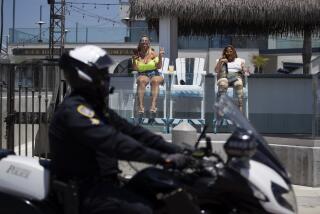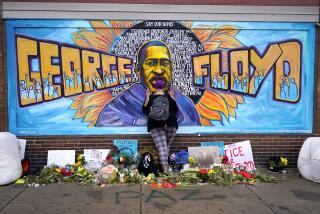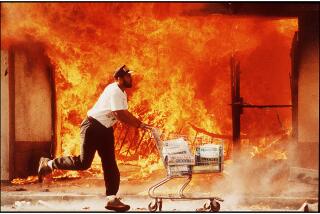Is Our Society Erasing the Thin Blue Line?
- Share via
Ever since the Los Angeles riots of 1992, I thought I would never again see police standing by as criminals smashed windows, looted stores, burned cars, terrorized people in their autos and set police cars on fire. But I did, just Monday night.
After the Los Angeles Lakers won the National Basketball Assn. championship, roving bands of young men challenged civilization as most of us understand that term.
While that is awful, it is unworthy of much attention. Every society has thugs.
What is worthy of immense attention is the absence of police intervention. While media people, City Hall and police headquarters are all telling us that the police should be commended for a wonderful job, the fact remains that for hours people were terrorized, stores were looted and police and other vehicles were destroyed and burned--all within a block or two of hundreds of police personnel. Yet the police did not stop one criminal and arrested a mere 11.
The question is why.
There are only two possible answers.
One is that Los Angeles Police Department cannot deal with violent mobs, even on a relatively small scale. If this is so, its leadership should resign because it has not warned the citizenry of the department’s impotence. Furthermore, Los Angeles would be morally bound to immediately inform the Democratic Party that it should not have its national convention in Los Angeles. If the police are incapable of handling post-basketball mobs, they certainly cannot handle the expected mobs at the convention.
The other possible explanation is that the police are fully capable of stopping such criminality but are told not to do so when the crimes are committed by bands of blacks and/or Latinos (not all Latinos--Cuban-American rioters are treated as if they were white rioters).
I am convinced that the latter is the reason. Indeed, police officers anonymously called my radio show to confirm it. Yet even without police confirmation, this policy is obvious to all who have eyes to see. It explains why police in New York City ignored the many women who begged them for help after being sexually attacked at the Puerto Rican Day parade. It is an open secret in New York that the police were essentially under orders to avoid any confrontation with that Latino minority.
Unless an officer is directly threatened, police officers know that it would be best not to be seen confronting blacks or Latinos. Imagine if a police officer outside Staples Center wielded a baton against a black man who was smashing a car, and unintentionally seriously injured the man. The mainstream media would do their damage: Television news would repeatedly show the video of a white officer clubbing an African American male, and mainstream newspapers would all publish the still picture of it. On other liberal fronts, the ACLU would sue the police; the individual officer would be branded violent and racist; and upon his release from the hospital, the injured criminal would be invited to lecture at various universities.
The police and civilian authorities understandably figure: Who needs this? One must almost pity the good police officers. One can only imagine the humiliation felt by police sitting in their cars doing nothing while other police cars were being set on fire.
What we all need here is honesty. We must recognize that police in major urban areas often will not treat black and Latino mobs as they would treat most others. Indeed, while of course making no reference to race or ethnicity, in his statement the next day, Los Angeles Mayor Richard Riordan acknowledged that the policy was to have the police do little to stop the violence: “Their disciplined restraint minimized escalation of violence.”
Yet there are those of us who believe that this policy is a pact with the devil--a Chamberlain-like “peace in our time” form of appeasement of evil.
We do not understand how allowing evil makes society better.
We wonder about the effects on young people watching television and seeing criminals engaged in criminality and not being apprehended. What would you answer if your child saw these men setting a police car on fire and asked you, “Where are the police?”
We wonder about the effects of this policy on inner-city males who want to do good. Isn’t it obvious to them that society doesn’t support them and tolerates their antisocial neighbors?
And speaking about tolerance, how would you describe a society that has zero-tolerance for first-grade boys giving “unwanted” kisses to first-grade girls, for any students sharing their cough drops with a fellow student or for bringing a butter knife to school but seems to have quite a bit of tolerance for mob violence?
I would describe such a society as a morally confused one.
More to Read
Sign up for Essential California
The most important California stories and recommendations in your inbox every morning.
You may occasionally receive promotional content from the Los Angeles Times.










